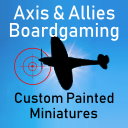@Titus Ah, Okay. Neat setup though!
Organization
-
Hi, in my Spring 42 2nd Ed. board game, the Western Front is way too crowded with German and Russian units. Even on the first turn, we have trouble figuring out which chips are fighting and who’s not. Any help for organization to make the game’s units a bit easier to see?
-
I would suggest using the chips instead of redundant pieces as much as possible, and also cutting some cardboard squares (or sheets of paper) that you can move the pieces to for battles, and then simply place the surviving units back on the board. I liked the number circles and corresponding cards that came with the previous game version, so I use those as well for fleets and stacks, but you could make your own quite easily.
-
Hi, in my Spring 42 2nd Ed. board game, the Western Front is way too crowded with German and Russian units. Even on the first turn, we have trouble figuring out which chips are fighting and who’s not. Any help for organization to make the game’s units a bit easier to see?
I find this an issue too, i would have liked to have the zones in europe to have sufficient space too.
Although my idea may not help you in your question i do have an idea
that find useful.All land units and aircraft on ships etc at the start of each turn “face south” and
when you move them, either in combat or non-combat turn them to “north”. At
the deployment stage turn them south again. This way you will know which have
been used and which have not. -
I use chips for every thing on setup and try to keep chips every where all the time and it helps keep things better organized.
I also try to keep the units from one nation together so they don’t mix with other powers units. Most zones can easily hold at least three stacks of units. There are a few trouble spots though.
One caveat to my earlier point about chips for everything is navies. When the navies get large enough it can be hard to keep the chips for each unit separate. I try to use the models for capital ships. Nobody wants an extra battleship to fight by accident!
Remember to keep the chips seated together as well. This will help keep confusion to a minimum. They have grooves for a very good reason.
I will post a pic of my setup. Maybe you can post a pic of yours too so we can see what the issue is.
German/Russian front:
http://imgur.com/Sn7MQB6Germany:
http://imgur.com/bQolRYO -
Here’s one trick you can use to deal with highly crowded map areas. You’ll require either two or three things, depending on how elaborate you want to be:
-
An auxiliary table, for example a card table. [Required]
-
Wooden tiles from a Scrabble game. [Required]
-
Square wooden blocks from the various Commands & Colors games. They come in about twelve different colours and shades – most of them a fair approximation of the A&A national sculpt colours – and are approximately the size of the Scabble tiles. [Optional but nice]
The Scrabble tiles are divided up by letter into 26 groups. Each player is given a few groups. The idea is that, instead of having a large group of sculpts on a map territory, a player can instead place a Scrabble tile on the map, then place an identical Scrabble tile on the auxiliary table and place his sculpts next to it. The letter of the two tiles serves to identify the group of sculpts on the auxiliary table (showing the composition of the force) and the corresponding tile on the map (showing the location of the force). This is repeated (with different letters) for any other forces the player wishes to represent in this manner.
As an optional refinement, each player takes a set of wooden blocks, in a colour that approximates their sculpt colour. The blocks are placed under the Scrabble tiles. This isn’t necessary to make the system work, and admittedly it’s an added expense to buy the required C&C games, but if you can afford it it has two advantages: it makes the forces on the board easier to identify (since they have colour designations) and it greatly multiplies the number of forces that can be represented in this way (since there can 9 x 26 colour-letter combinations rather than just 26 letters on their own).
-
-
You could still use the tiles and on a big piece of card stock, draw the territories bigger on card stock. Then you can place all pieces on card stock.
It be like the Capitals were drawin on the 87 game on the sides of map for more room.







